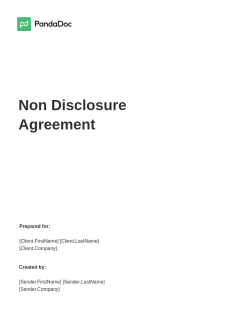Non-disclosure agreements (NDAs) have become common in the workplace today.
In fact, according to a study most recently updated in 2017, just over one-third of U.S. workers were required to sign an NDA of some kind, and that number’s unlikely to have fallen much since.
These contracts, which are also known as confidentiality agreements, are written agreements that prohibit parties from sharing information that’s confidential.
If you’ve got questions about how to make a non-disclosure agreement, we’ll address them below and offer insider tips, such as how to write a legally binding contract, along the way so that your NDA will be robust and protective.
What does a non-disclosure agreement do?
Non-disclosure agreements, AKA confidentiality agreements, are legally binding contracts that establish confidentiality between parties.
The party (or parties) who sign the NDA agree that any sensitive information they might be privy to won’t be shared with anyone outside of the agreement.
NDAs are a fairly common practice for businesses entering into negotiations with one another.
They have the benefit of allowing parties to share sensitive information and plans without worrying that the information will end up being seen, stolen by, or sold to competitors.
A mutual non-disclosure agreement is where two or more parties share information both ways and agree not to leak that information to outside parties.
If a non-disclosure agreement is breached by either party, the party whose information has been leaked can seek legal action to avoid and prevent any more disclosures and may choose to sue the offending party for monetary damages due to the leaked information.
However, proving that an NDA has been breached is tricky.
So these contracts are often used more as a deterrent rather than as a way to successfully collect damages — although this is possible.
Types of NDAs
While most general non-disclosure agreements contain the same basic information, you may need a specialized NDA based on the relationship between the parties that are sharing confidential information.
Here are a few types of generic non-disclosure agreements that you may need as a business owner:.
1. Patent/product development NDA
A patent-focused non-disclosure agreement allows a company to retain all confidential information regarding their patents or inventions.
This can be useful for startups or established businesses that don’t want employees, vendors, or other third parties to share information about their patent.
Similarly, product development NDAs protect sensitive information regarding a new product before a patent has been filed for it.
2. Employee NDA
An employee NDA informs an employee that he or she may not divulge sensitive information or trade secrets without first gaining the employer’s permission.
Even if you’re unsure what may qualify as confidential information, having employees sign an NDA before joining the company sets a good privacy standard.
Like employees, independent contractors may also be exposed to proprietary information.
These 1099 employees should sign an NDA before beginning to work for a company, just like regular employees do.
3. Job interview NDA
If your talent acquisition team is conducting interviews for a sensitive job, consider drafting a job interview NDA.
It’s possible that interviewers may divulge sensitive information when they ask prospective employees questions during an interview.
Employees who are hired typically sign NDAs, but what about those who didn’t get the job?
Because unhired interviewees may be exposed to confidential information, draft a simple NDA that each person you’re going to interview must sign before the interview begins.
4. Mutual NDA
These legal documents, which are also known as two-way NDAs, allow two different parties to share their trade secrets.
However, these two entities must still keep the information that has been shared between the two parties private.
5. Customer List NDA
If your company sells its customer lists to third parties, you’ll want to make sure that file doesn’t get into the hands of your competitors.
Draft a customer list non-disclosure agreement and have the third party sign it before you turn over this potentially lucrative information.
6. Business plan NDA
Perhaps you need to start attracting investors to your business.
A business plan non-disclosure agreement will come in handy here, as it will keep the details of your business plan secure after you pitch to investors.
This type of NDA can also be helpful for startups that need to show a third party the details of their business plan to receive funding, for instance.
7. Business sale NDA
On the other hand, maybe you’ve finally grown your business to the point that you want to sell it. Now’s the time to whip out a handy business sale NDA.
This confidentiality agreement is useful for keeping trade secrets and business information private during negotiations, such as mergers, investment discussions, potential joint-venture negotiations, and the final sale of a business.
How to write a non-disclosure agreement: What’s included?
Now that you know about the different types of NDAs, it’s time to find out how to write an NDA of your own.
Most standard NDAs follow this format:
- Introduction
- Definition of confidential information
- How to handle confidential information
- Exclusions from confidential information
- Obligations of receiving party
- Duration of agreement
- Resolving disputes
- Integration
- Choice of law
- Signature page with notarization
Easy enough, right? These sections are pretty self-explanatory, so you surely know what each of them should entail, don’t you?
Just kidding — we’ll break down each of these sections so that by the time you’re finished reading, you’ll know all the ins and outs of an NDA like the back of your hand.

NDA Template
Used 13434 times
4.1 rating (12 reviews)
This NDA Agreement Template can be used between a company and a vendor or subcontractor to establish confidentiality between the two parties.
Use this template01. Introduction
First and foremost, you’ll need to add an explicit title to the generic non-disclosure agreement.
It can be something as simple as “Non-Disclosure Agreement” or it could be a more specific title, such as “Product Development Non-Disclosure Agreement.”
You’ll also need to state the disclosing party, receiving party, and the purpose of the contract in the unilateral NDA.
The disclosing party is the party that’s disclosing confidential information.
The receiving party is the party that receives this information and is legally obliged to keep it a secret.
Of course, the purpose of the contract is to prevent the disclosure of sensitive information.
Here’s an example of what your standard NDA introduction should look like:
This Non-Disclosure Agreement (the “Agreement”) is entered into by and between ________________ (the “Disclosing Party”) and ______________ (the “Receiving Party”) for the purpose of preventing the unauthorized disclosure of Confidential Information as defined below. The parties agree to enter into a confidential relationship in regards to the disclosure of certain proprietary and confidential information (“Confidential Information”).
If both sides signing the NDA are disclosing confidential information to each other, the NDA should be adjusted to be a mutual non-disclosure agreement. In this case, the introduction would read as follows:
This Non-Disclosure Agreement (the “Agreement”) is entered into by and between _________________ (Party A) and _______________ (Party B) collectively referred to as “the parties” for the purpose of preventing the unauthorized disclosure of Confidential Information defined below. The parties agree to abide by a confidential relationship in regard to the disclosure by one or each of the parties of certain confidential information.
02. Confidential information
Following the introduction, you’ll need to define what confidential information is protected by the legal contract.
Depending on your business, you may have several classes of information that would be considered as trade secrets or otherwise confidential information.
A trade secret is defined as intellectual property that has economic value precisely because this information isn’t public knowledge.
Trade secrets can include everything from formulas, recipes, and processes to practices, designs, and instruments.
For example, Coca-Cola’s recipe for the Coca-Cola Classic soft drink is a trade secret, as the specific formula has led to the soda’s market dominance both in the United States and across the globe.
If everyone had access to this recipe, Coca-Cola’s profits would be diminished as competitors would rip off their secret formula.
There’s no doubt that anyone who has access to this prized recipe is bound heavily by strict NDAs.
Types of information protected by NDAs include but aren’t limited to:
- Standard Operating Procedures (SOPs)
- Formulations
- Technical information
- Financial information
- Architectural drawings
- Design blueprints
- Specialized tools
- Product specifications
- Prototypes
- Test results
- Software
- Customer lists
- Vendor lists
- Business methods
- Marketing strategies
- Technical know-how
- Medical information
If you’re making money off something that the public domain has no insider knowledge of, you’d benefit from writing your own NDA.
Your confidential information clause may resemble the description from PandaDoc’s free sample NDA:
“Confidential Information” means information, to the extent it is not a Trade Secret, which is possessed by [Disclosing Party] and which relates to [Disclosing Party], including, without limitation, for example: business plans, strategies, existing or proposed bids, costs, technical developments, financial or business projections, investments, marketing plans, or training information, materials, and examples of confidential information.
03. How to handle confidential information
Now that you’ve included the confidential information in the legal document, you should state how the proprietary information should be handled.
Depending on who’s designated as the receiving party, this may include researching the party’s confidentiality practices.
If you’re binding an employee to an NDA, this may not be necessary.
However, if you’re divulging confidential information to a third party, such as a potential partner or vendor, you’ll want to do your homework on how the organization handles confidentiality.
Next, define the standard of care.
This is essentially how strictly the confidential information should be handled.
Generally, NDAs state “commercially reasonable” or “in strictest confidence” to avoid negligent or willful divulgence of trade secrets.
The degree of standard of care will depend on the confidential information you’ are protecting.
In Coca-Cola’s situation, we can easily assume that anyone who has access to the prized formula is bound under the “in strictest confidence” standard of care.
An employee who must work with a partner or vendor may be held to the “commercially reasonable” standard of care, so they can share aspects of the confidential information that helps accomplish business-related objectives.
04. Non-confidential information
After you’ve explicitly discussed what information is protected and how it should be handled, the NDA must state which information isn’t confidential.
This may seem redundant, but it’s needed for clarity. Sticking with the Coca-Cola case, an example of non-confidential information would be the company’s bottling process.
Coca-Cola doesn’t make money off how it fills its bottles. It’s what’s inside them that counts.
05. Obligations of the receiving party
Next, it’s time to discuss the obligations of the receiving party.
This section describes how the receiving party must maintain the information’s confidentiality and limit its use. You’ll want to specify under which conditions the receiving party is permitted to reveal protected information.
This may be under no circumstances, or under special circumstances where the receiving party may need to work collectively with another party for business purposes.
If your NDA is a mutual agreement or a more complicated agreement, you’ll want a long-form statement that describes the obligation of the receiving party.
This may include requiring the return of all trade secret documents or the prohibition of activities that may leak confidential information to undesired parties.
06. Duration of the agreement
Another important component of a non-disclosure agreement is the time period of the disclosure of information and confidentiality.
First, detail the time period relating to information sharing.
This could be while the NDA is active or during the first few months of the relationship between the receiving and disclosing party.
This section will depend on the purpose of the NDA and the parties’ objectives.
Next, determine the effective date of the NDA and how long the duty of confidentiality lasts.
Generally, you’ll have three options: a fixed period of time, in perpetuity, or an indefinite period of time.
You may choose a fixed period of time by specifying that the agreement will be active until a certain date. If you want rock-solid confidentiality, opt for the in-perpetuity duration.
This forbids the receiving party from divulging protected information under any circumstances in the future.
For an indefinite period of time, you may state that the NDA is active until 1) the disclosing party decides to end the agreement or 2) the confidential information no longer qualifies as a trade secret because it has become part of the public domain.
07. Resolving disputes
You’ve laid the groundwork for most of the nitty-gritty NDA details. Now, it’s time to address disputes.
Although the purpose of an NDA is to avoid breaches of confidentiality, these things may still happen.
In your standard NDA, you’ll want to discuss what the remedy is for a potential breach of contract and any possible legal action that may be taken as a result.
Remedies can include, but aren’t limited to, money for damages, a predetermined fine amount, a court order known as an injunction, loss of employment, and the entitlement to an attorney’s fees that were spent on enforcing the legal contract.
Be careful, though, of specifying an amount of money for damages.
Some courts may refuse to enforce damages that are considered to be too high, and damages that are set too low may not protect your trade secrets securely.
It’s also wise to consider adding an alternative dispute resolution clause.
This section is basically about both parties coming together privately, whether that’s through a casual meeting or official mediation, to resolve any disputes.
Why is an alternative dispute resolution necessary?
For one, court proceedings are public information.
Many businesses would prefer to discuss disputes privately rather than sharing these proceedings with the world.
It’s also advisable to seek an alternative dispute resolution because it can often make things more easy and efficient.
Depending on where you file a court order, getting a hearing scheduled and a final decision could take weeks if not months.
Alternative dispute resolutions allow for a more speedy and flexible time frame compared to litigation.
08. Finalizing the NDA
While all of the aforementioned information is great, the document doesn’t mean anything until your NDA is properly finalized.
Follow these easy steps to ensure that your NDA is considered to be a legally binding contract.
1. Integration clause
In the simplest terms, the integration clause verifies that the signed copy of the NDA is the final version.
This clause ensures that parties can’t rely on past statements once the NDA is signed.
Furthermore, the integration clause may also stipulate that changes to the agreement may only be valid if they’re presented through an addendum.
An addendum is an official signed agreement finalized after the initial NDA was signed.
2. Choice of law
Next, specifying the choice of law in your NDA is critical.
This designates which state law applies to the non-disclosure agreement if a lawsuit should develop.
The easiest way to do this is to list that the agreement shall be governed by the laws of the state you work in.
3. Signature block
Once you’ve got the integration and choice of law formalities out of the way, it’s time to make room for signatures.
Each person who signs the NDA should have their own signature block. Include a line for the signature, the printed name of the party, and the date the NDA was signed.
4. Notarization
Finally, make sure your NDA is signed in front of a notary.
A notary public is a government-appointed official who witnesses the signing of important documents.
Notaries verify the identity of signers and their awareness of the details of the contract.
When drafting your notary section, be sure to include a line for the notary’s signature, the notary ID number, and the notary license expiration date.
If you want an easier and more time-efficient means of getting documents notarized, check out PandaDoc Notary.
Non-disclosure agreements vs. non-compete agreements
While non-disclosure agreements forbid parties from sharing trade secrets and other confidential information, it isn’t the only document that can give your business a competitive advantage. Enter, the non-compete agreement.
What’ is a non-compete agreement? This type of legal contract restricts employees or partners from competing in your industry during the business relationship or after it ends.
Many companies issue non-compete agreements to prevent their employees or former employees from jumping ship and working for their competitors.
You may want to consider adding a non-compete clause to your NDA if the benefits of such a clause sound tempting.
Including a non-compete clause streamlines your business’s competitive advantage.
Your employees or strategic partners will be fully aware of what they can and cannot do with your confidential information during your business relationship and after it’s ended.
If you do decide to include non-compete language in your NDA, be sure to include this in the title of your document in order to avoid confusion.
This can be as easy as stating “Non-Disclosure Agreement and Non-Compete Agreement” at the top of your document.
How to make an NDA legally binding
To ensure that your NDA is legally binding, follow these steps:
1. Include an integration clause
The integration clause is how you verify that the signed copy of your NDA is the final version. It allows parties to ensure that past statements cannot be used or included once the NDA is signed.
It can also state that any changes to the agreement will only be valid if added via an addendum.
2. Choose the applicable law
Select your choice of law for the NDA. This determines which law applies to the NDA if a lawsuit occurs. You can simply state that the agreement will be governed by the laws of the state in which you work.
3. Add a signature block
Create a space for signatures. Each party signing an NDA needs to be aware of how to sign an NDA correctly and have their own signature block, which should include a line for the signature, the printed name of the party, and the date.
4. Notarization
It’s advisable to get all parties to sign your NDA before a notary who verifies the identity of the signing parties and their awareness of the contract details.
Ensure that you include a line for the notary’s signature, the notary ID number, and the notary license expiration date.
As well as ensuring that your NDA has been drafted and executed correctly, the contract should be supported by consideration.
What happens when someone violates an NDA?
Usually, having an NDA is enough to deter people from revealing confidential information. But when someone does violate the terms of an NDA, it can have very serious consequences.
NDAs are civil contracts, which means that breaking them isn’t technically a crime in of itself.
But depending on whatever laws are referred to in the NDA, violating it could come with large financial penalties.
Violating the terms of an NDA leaves you vulnerable to lawsuits from the other party, and you could be required to pay monetary damages and even the associated legal costs.
Revealing trade secrets or sensitive company information to a competitor is illegal, and it can carry legal consequences, which include fines and potentially being made subject to an injunction that forbids you from disclosing any relevant information.
For instance, this could happen in the case of you disclosing private information regarding patents, trademarks, or trade secrets.
The injunction would keep the partner or employee from working for or with a competitor, and the monetary damages would help make up for the violation.
How to write an NDA: Easy NDA templates from PandaDoc
Don’t worry if learning how to create a non-disclosure agreement still seems intimidating.
PandaDoc has excellent free non-disclosure agreement samples and templates to give you a good idea of what the completed document should look like.
Writing a non-disclosure agreement doesn’t have to be stressful.
If you’re feeling a little overwhelmed about writing your own NDA, consider PandaDoc’s easy-to-use NDA templates.
Hiring a law firm to draft an original NDA can be expensive.
Utilizing PandaDoc’s NDA template is a quick and compliant way to ensure your company’s confidential information is protected.
Let PandaDoc do the legwork while you rest assured your confidential information is protected.
Download the free printable confidentiality agreement form by PandaDoc today to see just how easy it is to draft your own NDA.
Disclaimer
PandDoc is not a law firm, or a substitute for an attorney or law firm. This page is not intended to and does not provide legal advice. Should you have legal questions on the validity of e-signatures or digital signatures and the enforceability thereof, please consult with an attorney or law firm. Use of PandaDocs services are governed by our Terms of Use and Privacy Policy.
Originally published September 28, 2022, updated January 12, 2023


